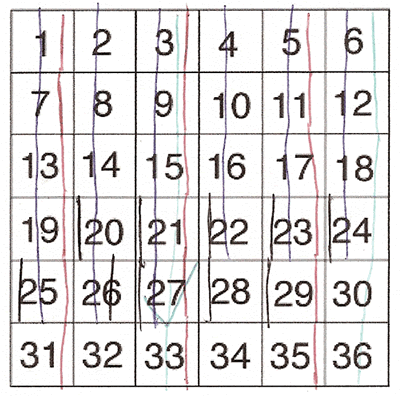Or search by topic
Number and algebra
Geometry and measure
Probability and statistics
Working mathematically
Advanced mathematics
For younger learners
One of Thirty-six



- Problem
- Getting Started
- Student Solutions
- Teachers' Resources
We had so many well-explained solutions to this problem - thank you all very much.
Adeline told us:
According to the first and second statements the only possibilities are 3, 9, 15, 21, 27 and 33.If the third statement then says that it is smaller than 28 (7x4) then the remaining numbers off the list are 3, 9, 15, 21 and 27.
It then says that the tens digit has to be even so then the numbers 3 and 9 are immediately scraped off (because they don't have a tens digit!) leaving 15, 21 and 27. 15 has the tens digit 1 which is not even leaving the only two possibilities 21 and 27.
The last statement then says it is the bigger of the two and that is 27. So the number is 27.
Kaitlyn from Mason Middle School made a table to help her:
The answer is 27. I know this because I used the process of elimination with the given hints. The way I did this was:| Hint | Possible numbers |
| The number is odd | 1,3,5,7,9,11,13,15,17,19,21,23,25,27,29,31,33,35 |
| The number is a multiple of three | 3,9,15,21,27,33 |
| It is smaller than 7x4 (=28) | 3,9,15,21,27 |
| The tens digit is even | 21,27 |
| It is the greater of the two possibilities | 27 because that is greater than 21 |
Dylan from Oakland Township Elementary used a similar method, but he explains how he used the number grid itself to write on:
Thank you, Dylan. Crossing out or circling the numbers as you go along can help you keep track of what you're doing. Daniel from Engelfield Green Infants School did this too. Here is what Daniel wrote:
Here is a picture of Daniel's work:

Thank you again for all your contributions to this problem. I'm afraid there are too many to mention you all!
You may also like
Number Round Up
Arrange the numbers 1 to 6 in each set of circles below. The sum of each side of the triangle should equal the number in its centre.
Grouping Goodies
Pat counts her sweets in different groups and both times she has some left over. How many sweets could she have had?

